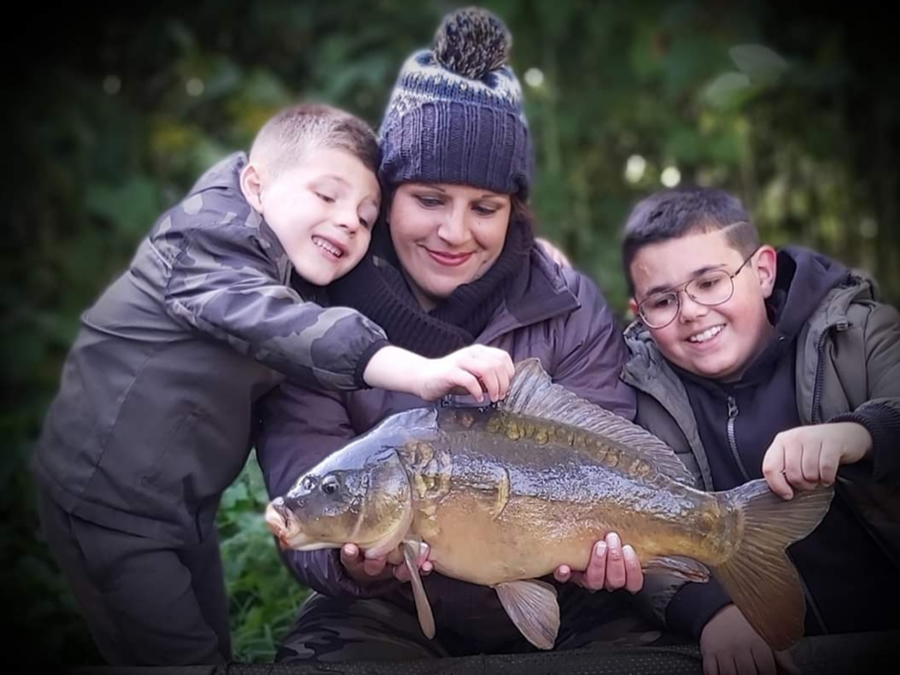Otter Predation
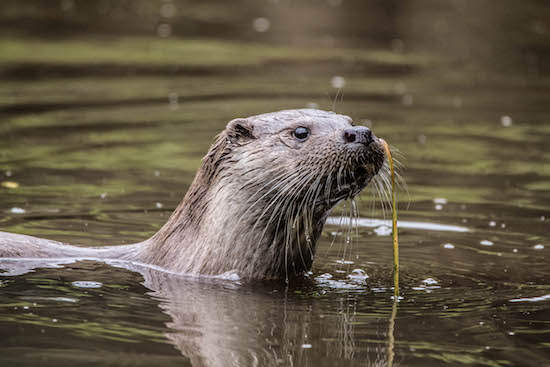
Background
As otter numbers have successfully recovered across most parts of the country they are at times having an impact on some fisheries through predation of stock. In the last few decades while otter numbers were low, still water fisheries stocked with large carp became widespread throughout the country and specimen sized fish became a real prospect in our rivers due to improved water quality, habitat and little predation. Now otters have returned to most areas, they are presented with foraging opportunities that sometimes comes into conflict with angling interests, with numerous examples of expensive or highly prized specimen fish being taken by otters.
The Angling Trust welcomed the Predation Action Group’s publication ‘The Big Picture’ because it is a useful collation of the many reports of damage to fisheries from predation and confirms once again that there is a serious problem with predation, including by otters, on many still water fisheries and some rivers. Otter numbers recovered following the banning of the pesticide DDT and a programme of releasing captive-bred otters in the 1980s and early 1990s. There is no evidence of any releases since 1999.
The Environment Agency published the 5th Otter Survey of England 2009-2010, providing an overview of otter recovery up to that point and an informative document for those interested in how recovery has happened. Please click here to read this.
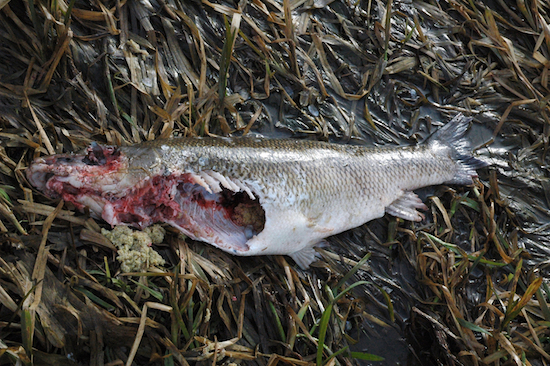
This 18lb barbel – a huge and irreplaceable specimen fish – was killed and partially eaten by an otter. Photo credit: the Predation Action Group
Angling Trust & IFM hold workshop on otter predation
On Friday 8th June 2018, the Angling Trust and the Institute of Fisheries Management (IFM) held a workshop entitled ‘Otter Predation: Finding Ways Forwards’ to:
- To highlight myths and facts around the impacts of the otter revival on fish and fisheries.
- To examine practical measures that can be delivered.
- To assist IFM and AT to produce a new and useful guide to fishery owners and angling clubs.
- To look at sensible policy reforms that could be considered.
- To consider existing research from Cardiff and Bournemouth Universities and possible new areas for study.
- To allow the EA, NE and others to set out their positions.
- To consider other impacts on fish populations including: habitat loss, barriers to migration, destruction of spawning sites, pollution and abstraction.
The workshop was well attended by top river and still water anglers, representatives from government agencies, the Predation Action Group (PAG), Carp Society, Wild Trout Trust and many others. The summary and outputs from the workshop can be downloaded here.
List of presentations:
- Environment Agency Policy and Position – Roger Handford & Graham Scholey
- UK Wild Otter Trust – Dave Webb
- Predation Action Group – Tony Gibson
- Cardiff University Otter Project – Dr Liz Chadwick
- Bristol Avon Impact Study – Stuart Morgan
- Fishery Predation Survey Project – Paul Floyd
- Impacts of otter predation on trout farms – Tim Small
- Bournemouth University Study on Hampshire Avon Otter Diet (Rob Britton – presented by Pete Reading)
- Can habitat quality influence predation risk? The case of spawning gravels and fish egg predation (Andrew Pledger, Loughborough University)
- Otter Impacts on Stillwater Fisheries (Chris Burt)
- Fencing and Deterrents – Matthew Pettitt
- Utilising the Angling Improvement Fund (Andy Petch)
Action
Following two year’s work with the Angling Trust, Natural England, fishery owners & anglers, the UK Wild Otter Trust has secured England’s first class licence from Natural England for the live capture & transport of otters. Please click HERE to find out more.
The Trust made a call for measures to manage the problem –
Please click HERE to see these along with the progress we’ve made so far.
The Angling Trust has also set out an action plan to address otter predation, which was agreed with the Predation Action Group in 2014.
Please click HERE to view the Angling Trust Action Plan on Predation.
Licences
The Conservation of Habitats and Species Regulations provide for the granting of licences to prevent serious damage to livestock, foodstuffs for livestock, crops, vegetables, fruit, growing timber or any other form of property or to fisheries. However, a licence cannot be granted unless the licensing authority is satisfied:
• that there is no satisfactory alternative, and
• that the action authorised will not be detrimental to the maintenance of the population of the species concerned at a favourable conservation status in their natural range.
Licences for the prevention of damage in England are determined by Natural England. Satisfactory alternatives might include exclusion techniques (e.g. fencing) or the use of deterrents. However, it should be noted that the use of deterrents themselves, in some circumstances, may require a licence.
Although licences can be issued for what would otherwise be offences under the various legislation, for conservation and development purposes (the latter only under the Habitats Regulations), strict criteria are used in assessing licence applications. As long as suitable alternative methods of resolving the problem exist (e.g. fencing), it is very unlikely that any licences would be issued to trap and remove otters which are predating a fishery, and such licences would normally be refused.
Otters are territorial animals, and removing an individual via lethal control for example will create a vacuum which will be occupied by another otter in due course. This would therefore be only a short-term, ineffective solution, and not acceptable on conservation grounds for a European Protected Species.
In 2016, Natural England introduced a specific Class licence – Otter: live capture and transport (ref. WLM – CL36). This licence allows only registered persons to catch, move and release Eurasian otters, which have inadvertently become trapped within a fenced fishery for preventing serious damage to the fishery.
This licence may only be used at fisheries that have been appropriately fenced to prevent access by otters.
Further details of the Class licence (WLM-CL36), including Annex C – Otter Fencing Specification may be found here.
Fishery Management & Fencing
The amount of damage from otter predation to a fishery can be greatest where there are large, uniform ponds with poor marginal structure and little cover, and those which are populated primarily by large fish. Better fishery habitat management, introducing more marginal vegetation and woody debris for cover, and a healthier fish population age profile can sometimes help to reduce predation impacts.
Otters are resourceful and quite good climbers, so to be absolutely certain they can’t access a fishery a robust fencing specification is needed, with the greatest success achieved with fences which are buried in the ground at the base, have electric scare wires and an outward overhang. When the Environment Agency and Wildlife Trusts were producing their recommendations in the ‘Otters and Stillwater Fisheries (2008)‘ guide, there was strong pressure from the fishing industry to recommend this robust solution as the preferred option, although it is expensive. Even with the high security solution, fishery managers and anglers have to remember to attend to weak spots and to secure the gates and then close them.
In recent years a great deal of time and effort has been given by those passionate about their sport in trying to find fencing solutions to the predation dilemma faced on some fisheries to safeguard their prized and highly valuable fish stock.
The Angling Trust is working closely with a variety of key stakeholders including Embryo, Otterstop, the Carp Society, the Predation Action Group, UK Wild Otter Trust as well as the Environment Agency to better protect fisheries.
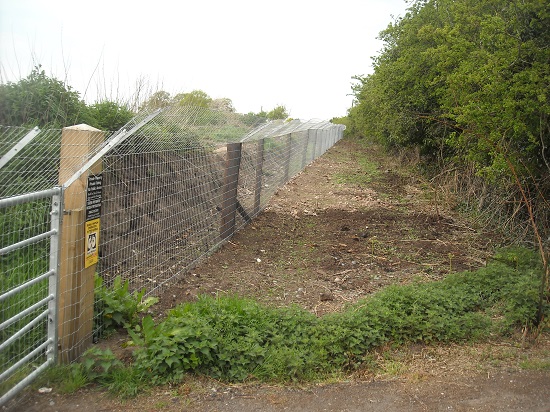
A secure otter fence at Blakemere Leisure, funded by the Angling Improvement Fund (more details below)
Otter Fencing Specification
Within Natural England’s Class Licence (WLM-CL36), Annex C provides guidance on the specification of the fence required to prevent an otter from gaining access to a fishery and to fulfil the licencing criteria.
The objective of otter fencing is to provide a robust, physical barrier that the otter can neither climb over nor pass through or under. Otters can pass through gaps greater than 75mm2 and an adult otter can easily stretch up to a height of 1m and can climb well.
Essentially, the fence can either be non-electrified or electrified, or a combination of the two as detailed below. In either case, fences must be regularly inspected and maintained, including clearance of overhanging and nearby vegetation.
Non-electrified Fence
- The fence should be constructed of material that otters cannot easily bite through, such as a mesh of at least 1.1mm diameter. The maximum mesh size for fencing to exclude otters should be 75mm2, with specific light high tensile galvanised wire products measuring 50mm x 100mm.
- It should be at least 1800mm high if there is no overhang at the top or at least 1200mm if there is a 600mm overhang towards the outside.
- If possible it should be buried 300mm into the ground. At the bottom of the fence on the outside there should be a ‘skirt’ of at least 900mm of a suitably robust but flexible netting that is securely pinned on the ground. Grass should be allowed to grow up through the netting to help secure it to the ground.*
- Fence posts should be treated timber or metal with straining posts of 15mm (6 inch) diameter at appropriate distances to support the fence around all angles. All posts must be inside the mesh of the fence.
- The outside of any gates must be covered in sheet metal (e.g. galvanised tin) or the same wire as the fence (and to the same height). The covering must extend to just above the ground and over any hinges or gaps that the otter could use to climb or squeeze through. Gates should be set over a hard-standing or material that cannot be dug.
- Additional protection can be provided by including an electric ‘scare wire’ attached to the fence posts and positioned so that the otter will touch it and receive a shock if it tries to climb the fence.
- This should be positioned 50mm below the top of the fence and offset no more than 50mm out from the fence line.
- A second electric wire may be a useful deterrent in the absence of an overhang. It should be positioned at least 300mm from the ground and if possible 150mm in front of the fencing mesh.
*Refer to Aftercare Maintenance later
Electrified Fence*
- Minimum requirement is 1.5 Joule energiser with a fast pulse rate.
- It is essential that vegetation is kept clear of the fence as this will short it
- The fence must be live as soon as it is erected to prevent otters from learning that they can cross it.
- Electric netting must be at least 700mm high
- Electric wire fencing usually comprises at least 3 parallel strands 70, 140 and 210mm from the ground. Four strand fences at 100, 150, 200 and 300mm above ground are also used. The wires must be prevented from touching each other.
- The wires must be tensioned by a reel post placed at the end of the fence and held by adjustable plastic insulators on metal stakes. Anchor posts should be used for bends and corners.
- The stakes should be spaced no more than 10m apart; they may need to be closer to cope with undulations in the ground.
*When using parallel strands of electric wire alone, it has been known for otters to still gain entry.
Embryo and Otterstop have been at the forefront of fencing fisheries to protect them from otter predation. A wealth of information is available to anyone considering fencing their waters on the following links:
Otterstop has produced a very informative video outlining some of the key features and techniques of installing a robust otter fence, which can be viewed here.
Given the growing demand, there are now several reputable fencing contractors across the country and a few manufacturers/suppliers of specific high tensile otter fencing to choose from, so fisheries should consider all their options.
Similarly, the fencing is not restricted to light high tensile galvanised wire alone, with a few alternatives available to suit the particular site and budget, whether that is chain link, galvanised mesh (50mm2), hexagonal wire mesh, electric fencing etc.
Preliminary checks
Whether you intend to undertake the works yourself, or hire a contractor, a few preliminary checks may prove beneficial:
- Ensure you are legally entitled to erect the fence, or have the legal agreement of those parties who own the entire area of land & water body concerned.
- Ensure the area to be fenced is not a legally protected site, e.g. Site of Special Scientific Interest (SSSI), Special Area of Conservation (SAC), Special Protection Area (SPA) etc. If so, you should consult with the appropriate statutory authority.
- Depending on the finished height of the fence and the proximity to a public highway, check that planning permission is not required. If in doubt, consult with your local planning authority.
- Check the line of your proposed fence (including any overhang) is not impeding a public right of way.
- If your fence design incorporates an outward overhang, do not allow your overhang to straddle over, or beyond your legal boundary.
- Plan the fence line to avoid fencing in, or disturbing an active badger sett and ideally avoid active badger runs.
- Make sure that you don’t inadvertently fence an otter inside. It’s advisable to have a careful sweep through the fishery and islands before you secure the final section, although if you know there is already an active otter holt within the fishery you will need to discuss the licensing implications with Natural England. If possible consider leaving a weather proof radio playing, and flashing lights for the final night before the site is enclosed.
- Depending on the surrounding tree cover and how much fence line clearance is required, check:i. Do you require a felling licence? (Ordinarily 5m3 per calendar quarter is permissible, but check with the relevant statutory body)ii. Do you have the relevant owner’s permission before you start clearance works, or removing any tree boughs?iii. Are the trees protected via Tree Preservation Orders, Listed Parks & Gardens, or does the site lie within a Conservation Area?iv. Are there roosting/hibernating bats, or nesting birds present? If the latter, plan ahead and undertake the works outside of the bird nesting season.
- If the fencing works involves burying the ‘skirt’, be conscious of how much damage may be incurred to the surrounding tree roots, which may then subsequently either kill the tree, or weaken it sufficiently causing it to fall across the fence, highway, property etc. at a later date.
- Have your chosen contractors (or fishery, syndicate/club members) the relevant level of expertise & competence to erect a secure otter fence?
- Have the contractors (or fishery, syndicate/club members) the relevant third-party liability insurance cover?
- Have the contractors (or fishery, syndicate/club members) the relevant expertise to comply with the appropriate Health & Safety requirements?
- Is the fencing scheme notifiable under what is termed the Construction (Design and Management) Regulations 2015?
- In all cases, check the proposed fence line for underground cables/utilities etc
- If the line of the fence is close to a main river watercourse or is on an active flood flow route, it may require a Flood Risk Activity Permit from the Environment Agency. Please check on-line on gov.uk to confirm which watercourses are main river, or talk to your local Environment Agency office.
If you are employing the services of a contractor and to avoid any misunderstanding, it would be advantageous to have a contract of agreement, between yourself as the client and the contractor undertaking the works, which includes a detailed specification of the materials to be used, illustration and methodology.
Upon completion, but ideally whilst works are being undertaken it is essential that the works are inspected, and any snagging problems resolved.

Large (and valuable) specimen carp are particularly vulnerable to otter predation, but many still water fisheries can be fenced to exclude otters. Grants are available from the Angling Improvement Fund (see below)
Attention to detail
- Ensure that all inlets & outlets, both above & below the water level are secure and otter proof. Some of these may need to be constructed so they can be removed and cleared of debris.
- Any low overhanging, dead, dying or diseased trees surrounding the fence should be removed.
- If a skirt is being incorporated within the fence design, ensure this is securely affixed to the ground along its entire length and ideally covered with soil, turf or aggregate.
- Ensure that all fence posts and especially straining posts/struts are erected inside the fence line to prevent them acting as a ramp thereby providing an otter with the opportunity to climb.
- Where two rolls of wire have been joined together, ensure that the spacing remains no greater than 50mm.
- Ensure that no fence wires have become broken or splayed, paying particular attention towards those at ground level.
- Gates should be hung so that when . there is no gap greater than 50mm on either the hanging or clashing side, or underneath the gate, whereby an otter may gain access. And, ensure there is a solid base beneath the gate to prevent an otter being able to dig underneath.
- Clearly sign post your gates to highlight that they need to be kept securely closed at all times and ideally incorporate a self-closing mechanism.
- Consider using combination locks, especially on gates which are infrequently used.
Aftercare maintenance
Once the project has been completed, fisheries cannot afford to become complacent.
- The boundary fence in its entirety must be checked regularly, with some fisheries undertaking this daily. It is essential the boundary is checked immediately following severe gales and any damage repaired immediately. During the winter months, be conscious of drifting snow.
- To assist with the visual inspection of the fence line, encroaching vegetation may need to be controlled on a regular basis. Avoid using brushcutters, since these can easily damage and cut the fence wire.
- Check the inlets/outlets, especially following periods of heavy rainfall. It is imperative to inspect the base of any pipework and/or otter proof grills as over time water can erode underneath such structures giving access to otters.
- Ensure the gates continue to close properly. Replace any damaged or missing signs and ensure that all members and visitors remain vigilant.
- Look for possible entry points being dug in, or out by rabbits, badgers etc. In some circumstances this may require some rabbit control to be undertaken.
- If you use an electric fence to protect your fishery or incorporate electric scare wires in addition to a ‘barrier’ fence, then please ensure the electric circuit is intact, adequately powered and not shorting out and that the battery life is adequate.
- Be aware that mink are naturally smaller and more agile than otters and depending on the fence design may still be able to enter the fishery. Further details on how to control non-native American mink (Neovison vison) can be found under the best practice guidance here.
- Monitor boundary trees.
- Unfortunately, some sites have suffered from deliberate vandalism of their fence lines, with holes being cut through the fence, so maintain good relations.
- Finally, if you think you may have a problem and are unsure of the point of entry, then consider installing a trail camera(s). But, if you have found a possibly entry point, do not be too eager to block up that point, until you are satisfied the otter is back on the outside. Again, consider using a trail camera.
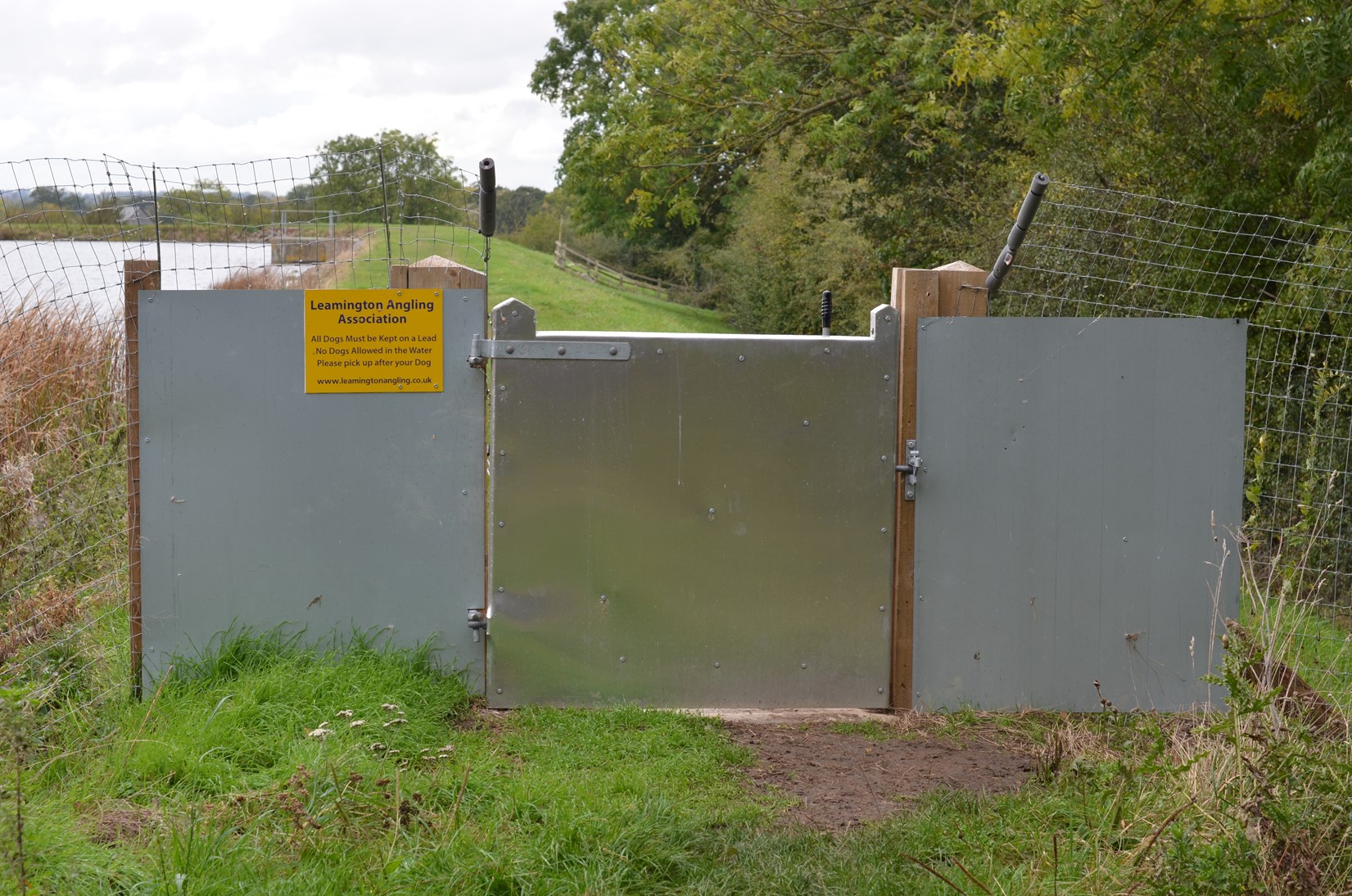
A self-closing gate complete with a concrete pad. With no gaps of over 50mm and clad with sheet metal, there is no way that an otter can gain entry.
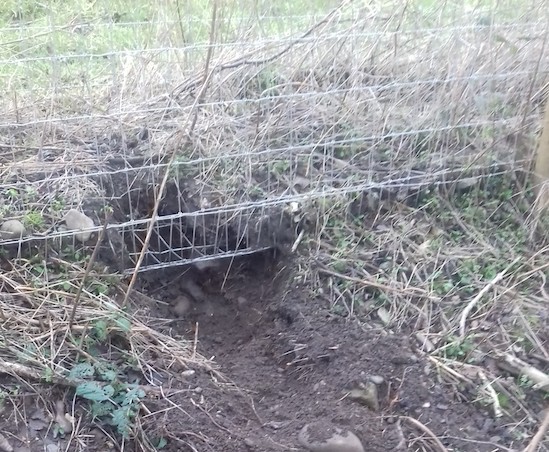
Rabbits can easily dig under fences that are not sufficiently buried or lack of skirt, so regular checks are necessary.
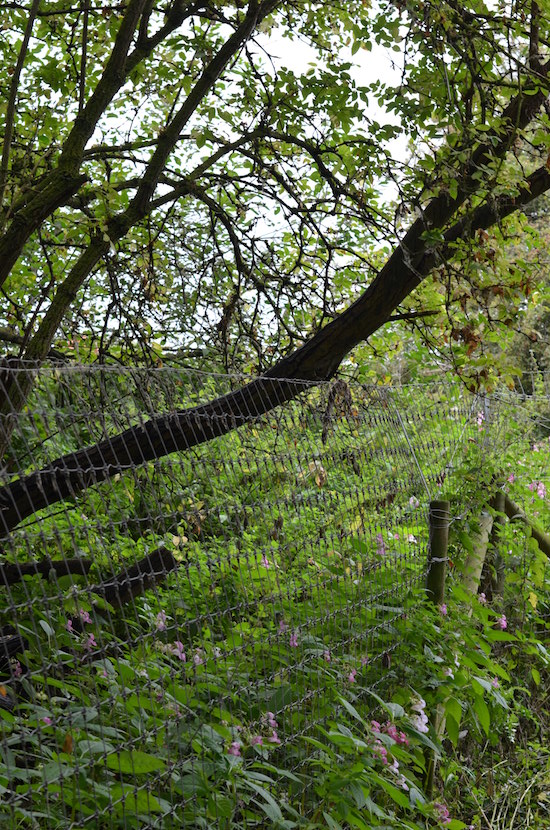
Otters are excellent climbers and therefore any tree boughs overhanging an otherwise secure otter fence represent an easy entry point.
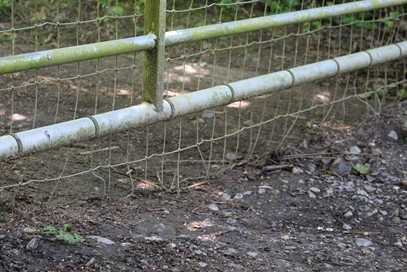
Over time, wire overhangs on gates will bend and break, leaving access points for otters. This needs a trim that will fit flush against the pad.

This gap of 100mm is a weakness
Funding Opportunities
The Angling Trust is aware of the tremendous pressures which predation can have on fisheries, whether that is cormorants, goosanders or otters.
To assist and help increase the availability of funding for angling, the Angling Trust, in association with the Environment Agency, launched the Angling Improvement Fund, which re-invests income from coarse, trout and eel rod licence sales in England in projects directly benefiting anglers. The Fund is open to all angling clubs and associations, commercial fisheries, charities and local authorities. Generally, up to £5,000 is available for individual projects, with occasionally larger sums of up to £20,000 being available for exceptional applications in particular funding rounds.
More details on how to apply, including key deadlines, standard application forms, and eligibility and judging criteria for each theme are available on the Angling Trust website here.
At the same time, be mindful of other sources of funding which may be available to fisheries from certain charities, local authorities and corporate organisations; e.g. Sport England.
Need support? Contact our Fishery Management Advisors
For further advice on otter related matters, please contact one of the Angling Trust’s Fisheries Management Advisors:
North West, North East, Yorkshire and Humber, Lincolnshire, East Midlands, West Midlands:
Richard Bamforth: [email protected] | 07904 041518
South West, South East, London, South Midlands, East of England:
Jake Davoile: [email protected] | 07949 703206
Further information:


